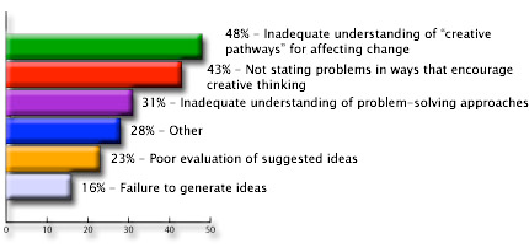Ever wonder what Apple designers, R&D researchers, Tesla engineers and Broadway directors have in common?
Creative thinking. But creative thinking doesn’t just happen in a vacuum. It is the outgrowth of an intuitive process of problem solving, that, when made explicit, unleashes the possibility for deliberate creative collaboration.
Creative problem solving (CPS) is the world’s most widely researched and disseminated model of creative thinking. The process reflects the natural way human beings approach and solve complex problems. It was first articulated by Alex Osborn in the 1930s and popularized in the 1950s with his book Applied Imagination. Over the past 60 years, it has become the universal creative process for complex problem solving, used as the foundation of many “proprietary” processes practiced agencies and corporations around the world.
More ideas surface and more new ideas are brought forward.
The heartbeat of creative problem solving is the separation of two distinct modes of thinking—diverging and converging. Diverging calls for the proliferation of possibilities, perspectives, and options. Converging requires the judicial selection of just a few. Think of a funnel: diverging is the wide mouth that collects from a broad range, and converging is the narrow spout that focuses the flow.
The advantage of separating these two modes? More ideas surface and more new ideas are brought forward.Creative problem solving is an open-source creative thinking model with diverging and converging built into each step. It offers a shared language and tools that support collaboration in groups and across organizations. Today, it serves many teams, organizations and fortune 500 companies as the core method for problem solving, cost optimization, and new product development. Some examples of organizations putting creative problem solving to use:
- A large packaged goods manufacturer reducedtheir product packaging and saved over $1 million inmaterials and transportation.
- After creative problem solving training, a sustainable agricultural company increased its patent disclosures by 50% in 2 years.
- A major new line at a synthetic fertilizer manufacturer was under performing. A special team was assigned to use the CPS process. Within two days they optimized the line resulting in an increase in revenue of $40,000 per shift.
- A cadre of CPS trainers at a major food and beverage company collected the ideas of 300 employees at a one-day forum and delivered millions of dollars in savings within one year.
The 4 basic steps of CPS, as articulated in the FourSight model include clarifying, ideating, developing and implementing.
Clarifying
Clarifying actually has three components:
- Identifying the goal, wish or challenge,
- Assessing the situation by becoming sensitive to context, information, trends, insights and research,
- Framing the challenge to produce thinking that achieves the desired future state.
Ideating
Ideating is the part of creative problem solving that most people know. It’s the classic idea generation of new ideas or “brainstorming,” (actually a term coined by Alex Osborn—though he would be dismayed at how it’s often practiced today). Of all the phases in CPS, ideating has the biggest toolbox and repertoire of creative thinking techniques. The primary output of this stage is a robust set of original ideas aimed at solving the creative challenge at hand.
Developing
Developing takes the initial solution set, produced during ideating, and fashions them into viable solutions. Often this involves examining the specific strengths and weaknesses of a potential solution through deliberate criteria and iteratively refining and elaborating the initial solution set. This is where prototypes come in, as a way to create low-risk experiments to improve solutions.
Leaders use CPS to tackle complex challenges and ill-defined opportunities.
Implementing
The last logical step is implementation. That is concerned with exploring issues of acceptance and action related to the solution. The output of implementation is a successful introduction of the final product. Study of the CPS process allows everyone to share the same language and tools for collaboration and innovation. Mastery of the CPS process allows a select cadre of trained facilitators to draw out the best thinking of groups. Leadership schooled in the CPS process can“lead forward” into complex challenges and ill-defined opportunities.
Creativity promotes productivity
In the KEYS creative climate survey, all seven of the ‘stimulants’ to creativity correlate positively with productivity. The two ‘obstacles’ to creativity have an inverse correlation with productivity. -- Center for Creative Leadership, User Guide to Keys: Assessing the climate for creativity





